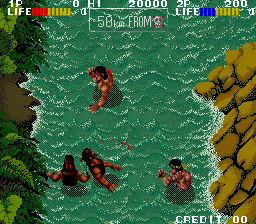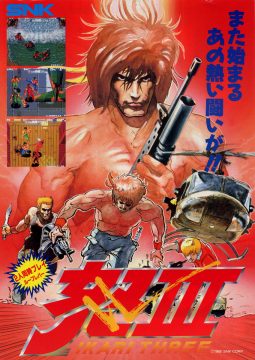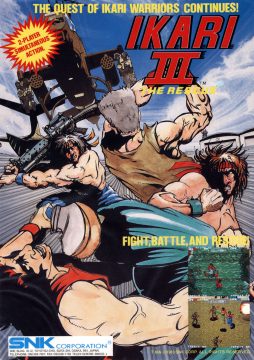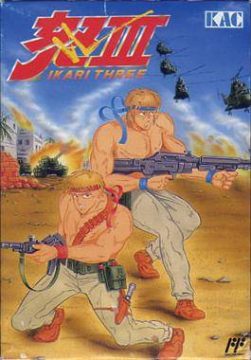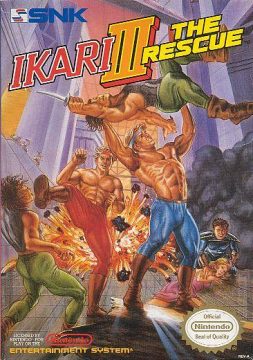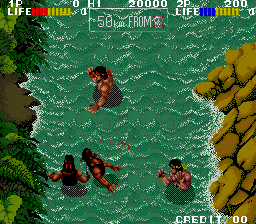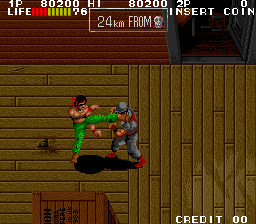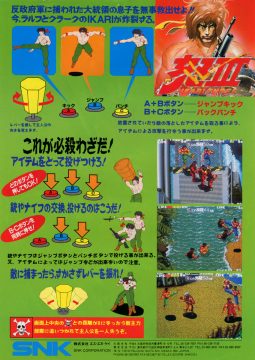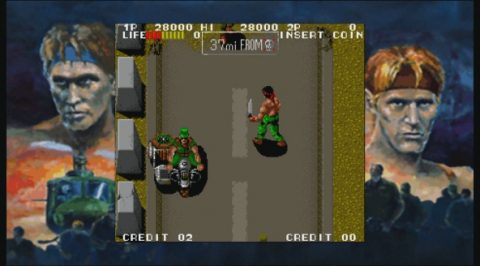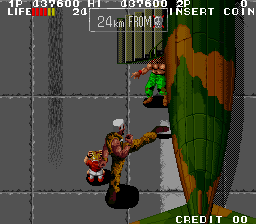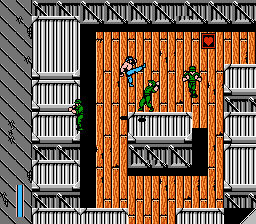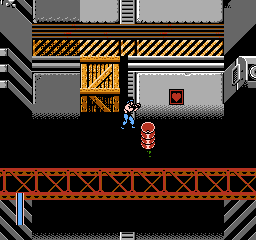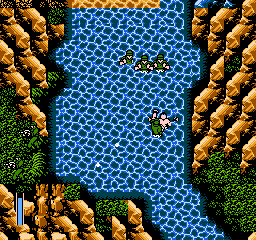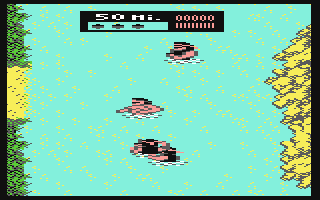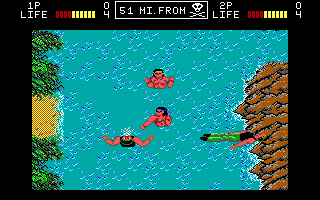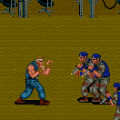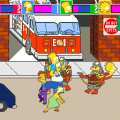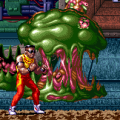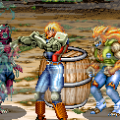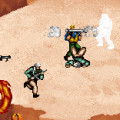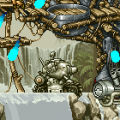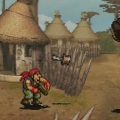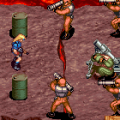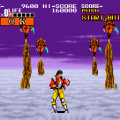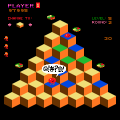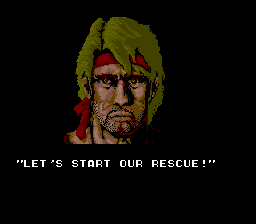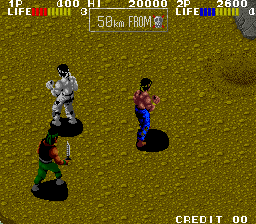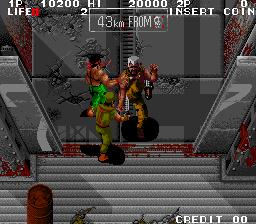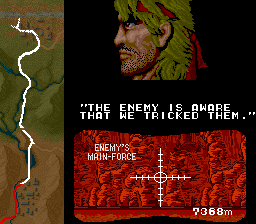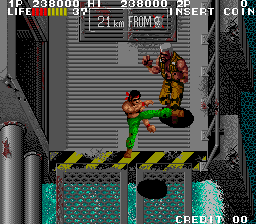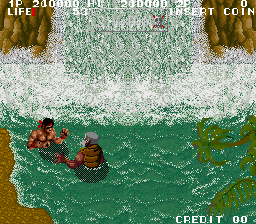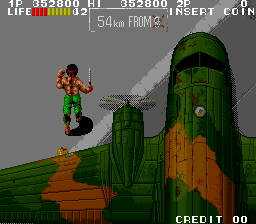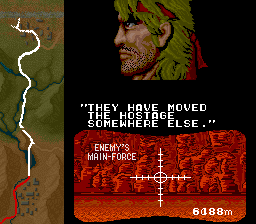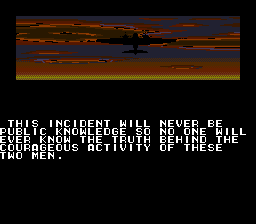- Ikari Warriors
- Ikari Warriors II: Victory Road
- Ikari III: The Rescue
The Ikari franchise remained dormant amidst the rise of other genres besides shoot-em-ups. While that particular genre was still going strong around this time, the arcade scene was booming with titles of various styles from many companies. Amidst this “silver age,” when console gaming was becoming more popular but the arcades still offered a lot of great stuff, the beat-em-up genre had become particularly hot thanks to titles like Double Dragon and Final Fight. The simple premise of beating the snot and pus out of multiple criminals at once was appealing, and the genre had a lot of other entries before it sadly faded out in favor of one-on-one fighting games. It could be argued that the popularity of fighters fostered by Street Fighter II not only extinguished beat-em-ups, but shoot-em-ups as well, which somehow became more scarce in ’90s arcades. Amidst all of this confusion, Ralf and Clark ironically wound up as characters in a fighting game series, but not before they had an interesting transition from shoot-em-up to beat-em-up in Ikari III: The Rescue.
Ikari III throws the rules of the previous two games down the smoking chimney. Instead of guns and blasting being the main focus, this game is all about kicks and punching. The story gets back to basics by pulling the heroes out of space and returning them to the Rambo-esque jungles and deserts of the Earth. The premise is that the president’s daughter is kidnapped for no reason other than to establish one of the oldest action film plots in the book. The Ikari Warriors are sent in to rescue her from a nameless terrorist organization which is somehow too poor to afford military weaponry for all of its troops. Unfortunately, budget cutbacks have also worked against Ralf and Clark’s favor, and they get sent into the fray with no other weapons besides their fists.
While the setting is back on Earth this time, it avoids revisiting the look of the first game by varying the terrain outside of mostly jungles with the occasional body of water or bridge to cross. Flowing rivers, bleak deserts, enemy buildings, and even a heliport at the end of the game are some of the locales to fight through. The game is actually structured into levels, divided into six semi-lengthy stages. The graphics are arguably the best in the series, not quite as dull and drab as the first game, nor as offensive on the retinas as the second. They’re not the most impressive visuals of the time, but they do show that the look of the series has evolved in three years’ time. The music, while still nothing special, is at least varied and even a bit catchy in points. The first level’s music is a decidedly bold tune, and the rest of the music relatively decent throughout. Nothing too outstanding, but it certainly does its job. The game has a good deal of voice samples that are mostly consisted of shouts and yells. They may get a bit grating over time, but they’re reasonably well done.
Obviously, this game is not going to play anything like its previously installments due to a poverty of bullets. For the most part, your guys are unarmed and duke it out with their fists and boots. There does not appear to be a great difference between kicks or punches, though punches are allegedly faster while kicks seem to hurt more. A third button allows the heroes to jump into the air to hopefully evade enemy attacks, and they can deliver a jump kick which is significantly more powerful than a normal kick but harder to connect. While most of the battles are fought unarmed, there are three types of weapons that can be picked up temporarily. Some enemies drop knives, replacing the fist with the blade and doing a good deal of damage per stab. Others throw grenades which you can pick up and toss right back. You can also find dynamite barrels or crates that instantly destroy anyone near the point of explosion. Most delicious of all is a rifle that last twenty shots and perforates any schmuck who gets in your way. However, if they get too close, it can be hard to aim properly. Ikari III‘s drastic gameplay change is neither an improvement nor detraction to the Ikari series. The rotating joystick mechanic is a bit more awkward to manage, as it’s really more ideal for a shooter than a brawler. However, the game was also released in a conventional eight-way joystick cabinet, so it could be played the “traditional” face-the-same-way-you-attack way as well.
Of course, all these changes still don’t do anything against the game’s quarter-vacuum properties. As is the standard with this series, you will likely be dying every few seconds despite your strongest efforts to ward off the waves of enemies that gang up on you. You do have a life meter this time around, but you don’t have much invincibility time to protect against it getting depleted rapidly. The usual standard in beat-em-up games cuts off constant damage flow in one of two forms: Either you get hit by enemies enough that you fall down and cannot be harmed while rising (barring some sort of cheap ground attack), or you have a special attack that blows off all surrounding enemies, usually at the cost of a bit of your health meter. Nothing like the latter helps you here, and while you can be knocked down in this game, it doesn’t always happen before you run out of life. In more cases than others, you get hit by a flow of minor punches and you die before having a chance to react. It’s total bullshit, but it just wouldn’t be an Ikari Warriors game without total bullshit!
The enemy variety isn’t too big in this game; you have soldiers in uniform and ruffians in headbands coming at you from all angles, who are naturally more agile than you can hope to be. They actually circle around you as they close in, staying just outside of your reach. Then there are these big bearded jerks who can usually kill you in a couple of hits and take a good dose of punishment. And then there are tanks and helicopters. While this seems like the type of game cruel enough to force you to beat up metal machines with your bare fists, you always have a soldier armed with a rifle when it comes to destroying these things. Honestly, taking on these machines is less of a struggle than being demolished by multiple soldiers at a time. Once again, Ralf and Clark are so not one-man armies, much less now that they have no weapons. The stages are technically short, but it can take so long to slog through them while attempting to kill every last enemy with their fancy footwork and impossible stun loops.
This is nothing to say of the time limit in the game. There is a message reading “##m to skull” at the top of the screen, and the number tells how far away a massive enemy congregation is from your current location. As you move on, you get more “time/distance” away from this force, but if it ticks down to zero and the enemy closes in, you get captured and have to start the entire level from the beginning. Needless to say, that sucks. Time limits are usually present in beat-em-ups, but they’re rarely a real threat; that’s not the case here, where getting booted back to the beginning of a level is a far worse fate than having to continue on the spot. Here’s the funny thing: If you have less than 25m on the distance gauge, dying and then continuing will recharge it to 25m! Unless you can beat up all enemies inhumanly quickly, repeatedly dying and continuing to replenish the timer is the only way to get through levels and end this game! It’s more of a danger to actually stay alive and have the enemy capture you. SNK actually invented a new, immoral way of to make players use up credits.
In the end, Ikari III is more of the same while being different. In spite of the genre shift, it’s still the good ol’ head-bashingly frustrating brand of pain for which the series is recognized. It’s perhaps the cheapest and most infuriating installment considering the timer, and that’s saying something regarding the series’ legacy of cheapness. Hence, it’s not a great game in the least, but it’s worth giving it a play for the hell of it. There aren’t too many overhead beat-em-ups out there, much less any that evolved from a jungle/space commando shooter series. It deserves more credit than Victory Road instead of just putting a coat of intergalactic paint on the game and adding a few new weapons, but the direction in which the gameplay has evolved is not necessarily a good thing. It’s clunky, the detection is a bit off, and one get so overwhelmed that it feels less like fighting for one’s life and more like fighting for the few seconds of invincibility granted on resurrection. Still, this installment does a good job of upholding the charming mediocrity which dictates the status quo of the Ikari games.
As usual, it is obligatory to mention the NES port of the game and how much it sucks… well, without the sucks part this time. No kidding, the NES version of Ikari III is a legitimately good title that is preferable over the arcade version. It’s not anything special, but it is less monotonous and more entertaining. Unlike the previous two games, some actual effort was put into this port. It has bright and vibrant graphics that, while average for an NES game released in the early ’90s, do their job well enough. The music is actually awesome, using mostly tracks from the arcade version but somehow punched up to a loud and energetic level. The gameplay is also improved, with better hit detection and less frustrating situations where you get cornered. The straightforward eight-way controls work better for this sort of game than the rotating style, anyway. You can punch, kick, and jump kick to defeat enemies, though for some weird reason, kicks turn the character around by 180 degrees; punches are hence preferable. In cases where your body is in water, the kick button actually grabs and throws down enemies to instantly off them.
The lifebar is now stronger, so you won’t be killed every few seconds, and there are several heart power-ups that increase your life entirely. You get all the weapons from the arcade game except for knives; grenades and machine guns are represented by icons while barrels are in solid form. The enemies mostly consist of green soldiers who attack in various ways with jump kicks, dash punches, knives, guns, and so forth. The game doesn’t distinguish between which soldiers can do what or how many hits each of them take, which is a bit annoying. There are a few unique enemies, such as knife-rushing commandos or ninjas. Seriously, ninjas! The bosses range from leaping mine tossers and apparent Mongolian swordsmen to giant tanks and armored vehicles (for which you get an infinite machine gun to take down). The fourth level actually breaks up the fighting for a vertically-scrolling shoot-em-up where you don diving gear and blast at swimming antagonists. It all sounds a bit ridiculous, and it is, but this is arguably the best game in the entire Ikari series. The NES version has unlimited continues, and you restart right from where you left off, making it just a matter of persistance to beat the game. However, the Japanese Famicom version only gives you three, making it practically inpossible to complete.
Ikari III wasn’t remotely as popular as its predecessors, so it was only ported to a few computer platforms. The Commodore 64 version is a disaster, with incredibly ugly, hugely pixellated characters. The DOS version actually looks and sounds relatively okay, so it’s the closest one would get to playing the arcade version at home – at least until the release of the emulated version for PSP.
Screenshot Comparisons
